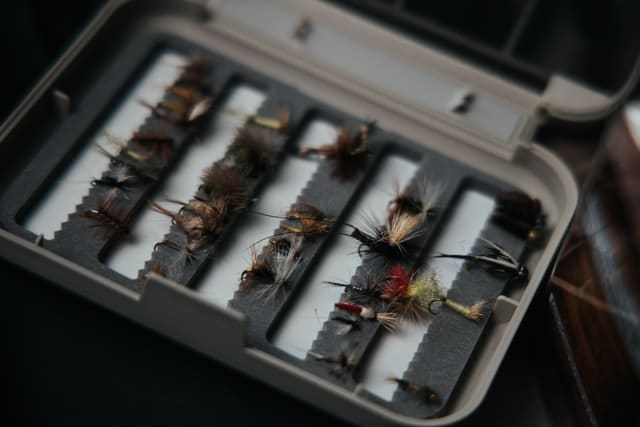Fly fishing is a method of fishing that uses a lighter form of bait (often called a fly) that, rather than sinks into the water, rests on top of it. The bait, which is often modelled to resemble a fly or insect, will look like a tasty treat to the fish and cause them to come up to the surface to attempt to eat the bait. Through fly fishing the lure is presented to the fish in the same way that a real fly which has landed in the water would be. Fly fishing is an art that requires a lot of finesse when it comes to selecting your spot when fishing, where you touch down your fly in order to increase your chances of getting a bite. There are numerous rivers, lakes and reservoirs throughout Kent where fly fishing is permitted. Bewl allows for fly fishing to continue for most of the year. If you are unsure about the regulations applying to a body of water in your area, the local council should have guidelines for whether fly fishing is allowed there.
This method of fishing often requires more finesse, so it is popular as a sport, with competitions bringing in a lot of interest. The fish most often caught while fly fishing are trout, pike, chub and carp, with other species often also taking the bait when presented with it. Here at Bewl Water fly fishing is available from the banks as well as from the boats available for hire on the reservoir. If you are new to fly fishing, then tuition can be provided by our fly fishing instructor – to learn more follow the link here.
Casting
The method of casting used when fly fishing is quite different to when fishing in the traditional form. This is to keep the bait on top of the water and to mimic the movement of a fly that has landed in the water. The techniques that are favoured by experienced fly fishers are different to conventional casting. When casting normally the line will follow the lure, which is often weighted so it will sink into the water. During fly fishing the lightweight lure follows the line as the ‘fly’ weighs as little as possible so it can sit on top of the water without sinking.
The casting method usually used with fly fishing involves a back cast as well as a forward cast, and the technique needed for a perfect fly fishing cast can be difficult for newcomers to fly fishing to learn. Going fly fishing for the first time with someone experienced who can teach you will be by far the best method to learn, as they will be able to watch your form and see where you could potentially improve.
Equipment
While the end goal is the same when fishing, the equipment needed for fly fishing is slightly different from the equipment used when you are fishing traditionally. Most traditional fishing kits will not work for fly fishing; a light lure or fly is a key part of fly fishing that you will need.
- Fly Line – When fly fishing it is the fly line that leads in terms of weight and determines where the lure will land. Finding a specific line that will work well for fly fishing can be difficult for someone new to the sport
- Fly – For fly fishing the lure is lightweight so it will rest on top of the water for fish to notice. There is a range of types, with thread and false modelled insects being popular choices.
- Rod – The rod you use should differ depending on the size and species of fish you are intending to target, with different rod weights and lengths depending on the fish you are aiming for. For best results most fly fishing rods are medium to fast action rods.
- Reel – A reel is used to release the line when you are casting and to control the amount that is fed out. Once you have a bite and a fish is caught, the reel is then wound up to bring the fish in. The reels used for fly fishing are very specific and can only be used for that purpose, as the reel and handle both rotate while casting.
Bait
There is a range of lures that are used to entice fish; listed below are some of the most popular lures and how they work. When fly fishing, the point is to keep the bait resting close to the surface of the water for the fish to locate, as if they were flies or other prey for the fish. Here are a few terms and lures that you are likely to come across.
Dry Flies
A dry fly is a lure that is supposed to sit on top of the water without sinking or getting wet. These are often created without an insect in mind, but the threads that make up the fly impact the water, attracting fish.
Wet Flies
Wet flies, however, are supposed to sit below the water, like an insect either laying eggs or that has begun to sink towards the bottom of the water. Feathers are often used to create the look of wings that will catch the attention of the fish in the area.
Nymphs
Nymph flies work very well as they are lures that are specifically modelled to look like naturally occurring nymph stage insects which will be typical food for fish. Nymph bait modelled after mayflies, stoneflies, caddis or midges are all popular. These are in fact a form of wet fly, and when used should sit under the water.
Streamers
Streamers are lures you use on an active retrieve as you reel the line back in mimicking a moving creature such as a smaller fish, crayfish or an aquatic insect. These are fun to use as they cover a lot of water with one cast and retrieve, and mean you can move along faster.
If you are planning a fly fishing trip to Bewl Water or want to know more about the sport, please contact us here. Our staff will be happy to guide you on what you need and where to go for a fantastic fly fishing trip.

